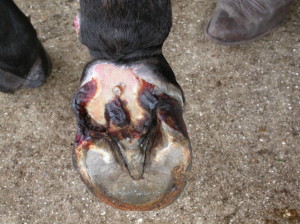
What The Muck Is That? ‘Swamp Cancer’
Each week we investigate one equestrian conundrum in “What the muck is that?” This week we take a look at Equine Pythiosis a.k.a. “Swamp Cancer.”
Although Pythiosis is relatively uncommon, it’s gross enough to warrant serious investigation.
So… what the muck is it?
Equine Pythiosis can be a fatal skin infection that causes tumor-like masses and lesions as well as gastrointestinal and respiratory disease. A fungus-like microorganism called Pythium insidiosum causes the infection. The disease is found worldwide but is known by different names: “bursatte” in Indian, “leeches” and “swamp cancer” in Australia and the United States, and “ferida da moda” in Brazil.
In the United States 60% of recorded infections are found in Florida, 25% in Texas, and the remaining 10% are generally found in Georgia, Louisiana, Mississippi and Alabama.
The microorganism loves warm temperatures and standing water, particularly flooded areas thick with vegetation.
Formation of the Pythium insidiosum’s sporangia and zoospores (a to h) and release of the flagellated zoopores in water (i).
What are the risk factors?
DVM360 reports “99% of the cases in horses are dermal infections that start with a break in the skin.” Riding or pasturing in wet grasses, swampy or boggy areas with weeds and briars can cause small cuts on the lower limbs.
How does it develop?
Pythiosis usually begins as a small irritated area. It may be mistaken as a sting, bite or small cut. But within a few days, the lesion will be much larger. It will also be extremely itchy. The horse may rub or bite at the lesion.
The lesion will continue to grow, becoming raw and irritated. Yellow to grey, pea-sized, chunk of dead cells will form in the lesion. These are called kunkers. The Horse reports, “These kunkers contain viable hyphae (microscopic structures) that are important for differentiating the disease from equine sarcoid, squamous cell carcinoma, granulation tissue, and other lesions.”
The lesion will continue to grow, eroding ligaments, tendons and bone. 95% of untreated cases will lead to death within six months.
How is it treated?
Before immunotherapy treatment.
Early treatment is a priority with this infection. A combination of immunotherapy, surgical removal of affected tissues including limb amputation, and chemotherapy is utilized.
After immunotherapy treatment.
How is it prevented?
Good wound care and keeping horses away from standing water might prevent infection.
Go Riding!
Photo Source: Biotechnology Kaiser Papers













Leave a Comment